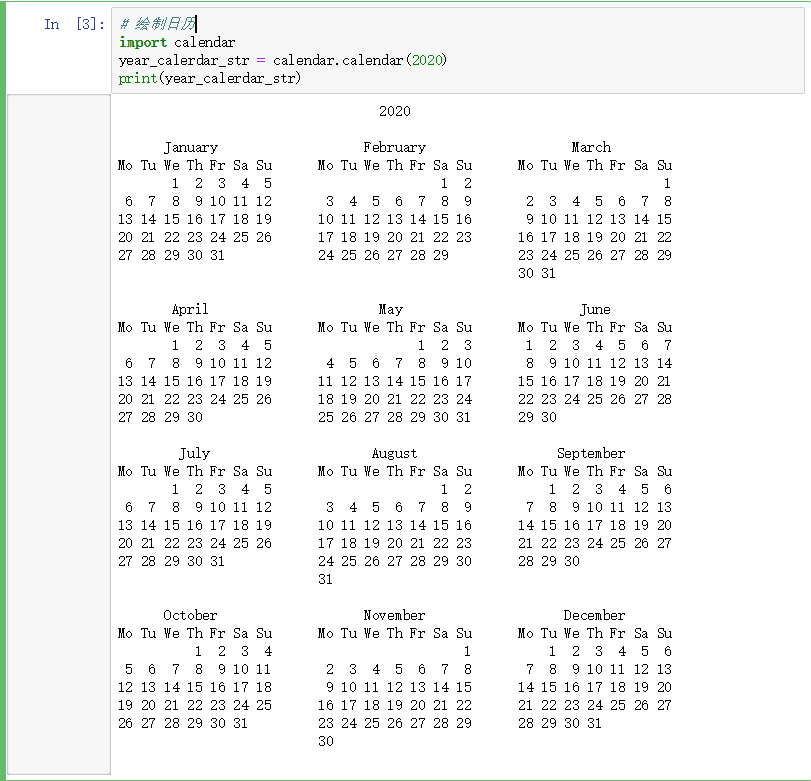Day 11:Python 时间模块
掌握 时间戳↔时间数组↔时间字符串 的转化。
我们在写程序时可能用到记录时间的地方,例如:
- 日志管理必然会记录时间
- 统计程序执行开始、结束时间
- 测试一个函数执行时长
python中与时间相关的模块:time && datetime
time模块表达时间的方法
- 设定一个零点作为基准(初始时间),偏移长度换算为按秒的数值类型,表示时间
- 由 9 个整数组成的元组 struct_time 表示的时间
time模块表达时间的方法
- -data: 日期类,包括属性年、月、日及相关方法
- -time: 时间类,时分秒
- -datetime: 时间日期, date的子类,年月日为必要参数
- -timedelta: 两个datetime之差,i.e. 差多少天多少小时多少分钟
P.S. 向比如说闰年判断,绘制日历,有现成模块可以调用:calendar
import calendar year_calerdar_str = calendar.calendar(2020) print(year_calerdar_str)

import time
import time # 1970-01-01 08:00:00 python 初始时间 # 验证初始时间 t = 0 # 时间数组 time.localtime(数) 亦称 struct_time print(time.localtime(t)) now_time = time.time() # 时间数组 time.localtime(数) 亦称 struct_time print(time.localtime(now_time)) #time 类 strftime 方法,转换 struct_time 为时间 字符串 print(time.strftime('%Y-%m-%d %H:%M:%S', time.localtime(t)))# 数组 - > 串 init_time = time.localtime(now_time) #time 类 asctime 方法,转换 时间数组 为时间 符串 str_time = time.asctime(init_time) print(str_time) # time 类 strptime 方法 format_time = time.strftime('%Y-%m-%d %H:%M:%S',init_time) print(format_time) # 第二个参数的时间格式,要匹配上第一个参数的时间格式。 str_to_struct = time.strptime(format_time,'%Y-%m-%d %H:%M:%S') #串->数组 str_to_struct
输出:
常用的时间格式:
%Y 年
%m 月 取值 [01,12]
%d 天 取值 [01,31]
%H 小时 取值 [00,23]
%M 分钟 取值 [00,59]
%S 秒 取值 [00,61]
import datetime
也可以:
from datetime import date, datetime, time, timedelta # 打印日期 Today = date.today() print(Today, " ",type(Today)) # 日期字符串 str_today = date.strftime(Today, '%Y-%m-%d') print(str_today, " ",type(str_today)) # 字符日期转日期 有点像(strptime )time摸块中的串类型转成数组类型日期 date类莫得,所以这样写 str_to_date = datetime.strptime('2021-03-24','%Y-%m-%d') print(str_to_date, " ",type(str_to_date)) 输出: 2021-03-24 <class 'datetime.date'> 2021-03-24 <class 'str'> 2021-03-24 00:00:00 <class 'datetime.datetime'>
关于 timedelta
两个相减的时间要一个类型 ! 年月日一定要!
def get_days_girlfriend(birthday:str)->int: import re splits = re.split(r'[-.\s+/]',birthday) # 输入时间间隔符为 - / 或者一个或多个空格 splits = [s for s in splits if s] # 去掉空格字符 if len(splits) < 3: raise ValueError('输入格式不正确,至少包括年月日') # 输入时间字符串必须包括年月日,忽略时间值。 splits = splits[:3] # 只截取年月日 birthday = datetime.strptime('-'.join(splits),'%Y-%m-%d') tod = date.today() delta = birthday.date() - tod return delta.days print(get_days_girlfriend('2021-03-23')) print(get_days_girlfriend('2021-03-25')) print(date.today()) 输出: -1 1 2021-03-24


 浙公网安备 33010602011771号
浙公网安备 33010602011771号